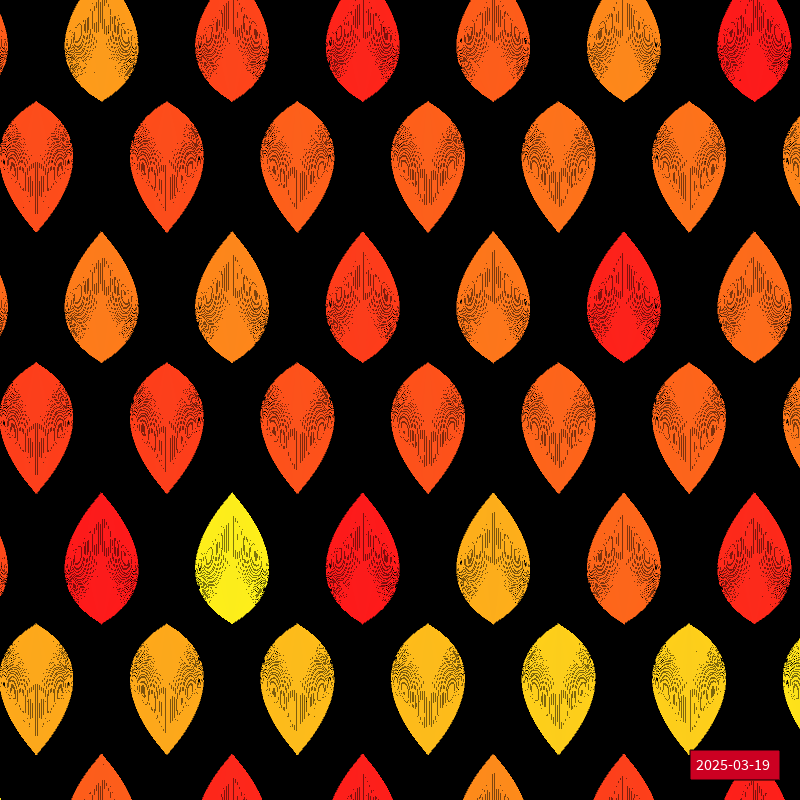"""2025-03-19
Onions
Usando curvas bezier, desenhamos uma sequência de formas que se parecem com cebolas
png
Sketch,py5,CreativeCoding
"""
from collections import deque
import numpy as np
import py5
from utils import helpers
from utils.draw import cria_grade_ex
sketch = helpers.info_for_sketch(__file__, __doc__)
def _bezier_meio(
p0: np.array,
p1: np.array,
distance: float,
v_rotated,
):
return p0 + distance * v_rotated
def calcula_passo(
hb: int, maxima: float, diff: float
) -> tuple[float, float, py5.Py5Color]:
distancia = maxima - diff
larg = (diff / maxima) * 2
h = hb
s = 90 - (diff / maxima)
b = 100 - (diff / maxima)
cor = py5.color(h, s, b)
return distancia, larg, cor
def desenha_forma(
p0: tuple[float, float],
p1: tuple[float, float],
hb: float,
angulo: float,
distancia_max: float,
num_passos: int = 5,
):
angle_rad = np.radians(angulo / 2)
x0, y0 = p0
x1, y1 = p1
p0 = np.array(p0)
p1 = np.array(p1)
v = p1 - p0
v = v / np.linalg.norm(v)
rotacoes = deque(
[
np.dot(
np.array(
[
[np.cos(angle_rad), -np.sin(angle_rad)],
[np.sin(angle_rad), np.cos(angle_rad)],
]
),
v,
),
np.dot(
np.array(
[
[np.cos(-angle_rad), -np.sin(-angle_rad)],
[np.sin(-angle_rad), np.cos(-angle_rad)],
]
),
v,
),
]
)
distancia_min = distancia_max * 0.1
passos = [
calcula_passo(hb, distancia_max, i)
for i in np.geomspace(distancia_min, distancia_max, num_passos, False)
]
for distancia, largura, cor in passos:
with py5.push():
py5.stroke(cor)
py5.stroke_weight(largura)
with py5.begin_shape():
for rotacao in rotacoes:
py5.vertex(x0, y0)
x_, y_ = _bezier_meio(p0, p1, distancia, rotacao)
py5.bezier_vertex(x0, y0, x_, y_, x1, y1)
py5.vertex(x1, y1)
def setup():
py5.size(helpers.LARGURA, helpers.ALTURA, py5.P3D)
py5.background(0)
py5.color_mode(py5.HSB, 360, 100, 100)
celula_x = 140
celula_y = 140
meio_x = celula_x / 2
meio_y = celula_y / 2
buffer = 0
hb = 15
for idx, xb, idy, yb in cria_grade_ex(
py5.width * 2,
py5.height * 2,
margem_x=-200,
margem_y=-200,
celula_x=celula_x,
celula_y=celula_y,
alternada=True,
):
x = xb + meio_x
y = yb + meio_y
angulo = 90
if idy % 2:
p0 = (0, -meio_y - buffer)
p1 = (0, meio_y + buffer)
hb = py5.random_gaussian(15, 20)
else:
p0 = (0, meio_y + buffer)
p1 = (0, -meio_y - buffer)
if idx % 2:
hb += 5
with py5.push():
py5.translate(x, y, -50)
py5.no_fill()
py5.stroke_weight(1)
desenha_forma(p0, p1, hb, angulo, celula_x, num_passos=40)
helpers.write_legend(sketch=sketch, frame="#CC0022", cor="#FFF")
def key_pressed():
key = py5.key
if key == " ":
save_and_close()
def save_and_close():
py5.no_loop()
helpers.save_sketch_image(sketch)
py5.exit_sketch()
if __name__ == "__main__":
py5.run_sketch()
